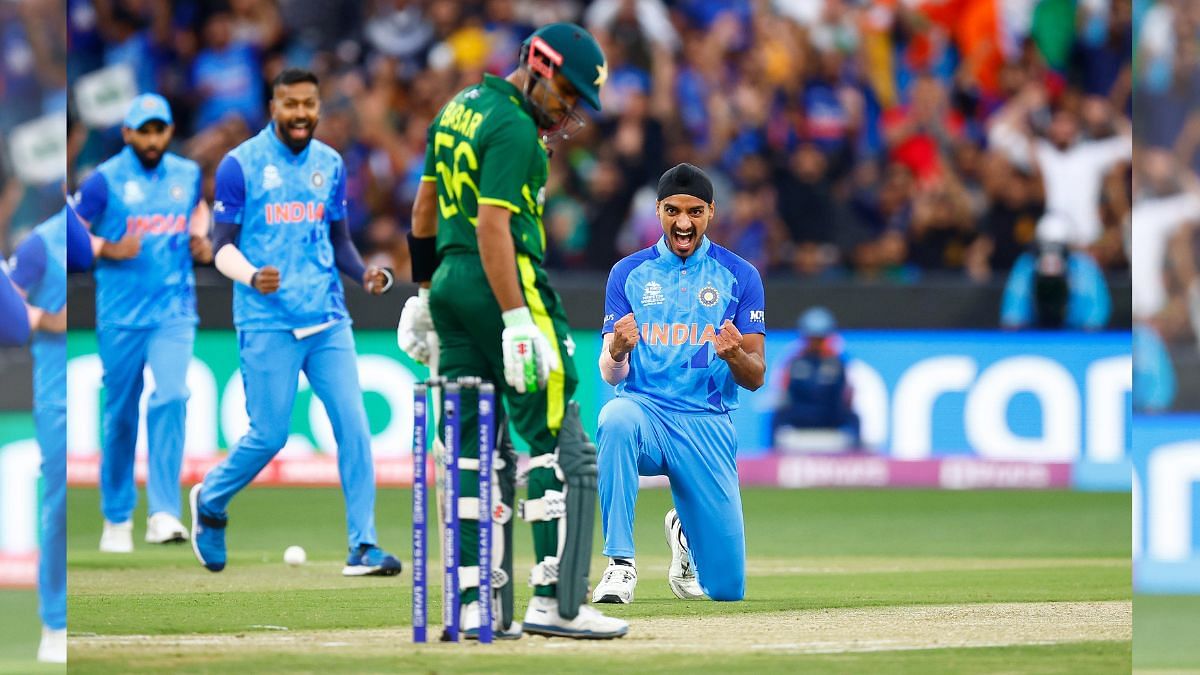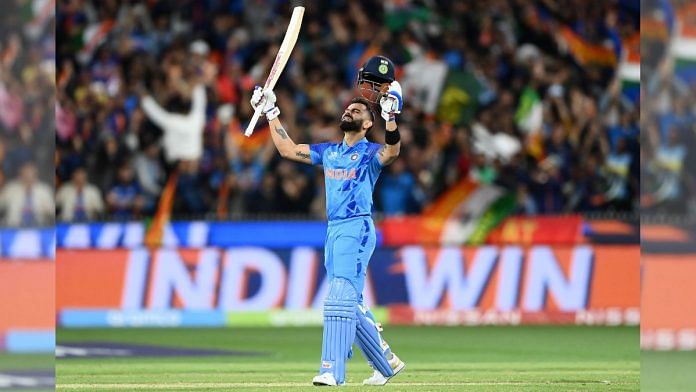New Delhi: Bilateral cricketing relations between India and Pakistan continue to be rocky off the field, given the controversy over the Board of Control for Cricket in India (BCCI) secretary and ACC (Asian Cricket Council) president Jay Shah’s remarks on Pakistan hosting the 2023 Asia Cup. However, the two sides’ on-field encounters remain electric, and Sunday’s game at the 100,000-strong Melbourne Cricket Ground was yet another T20 World Cup classic.
Kicking off Group B’s first round of matches at the tournament’s Super 12 stage, the close encounter hurtled along with either side in the ascendancy at various points on a green MCG surface that assisted pace and bounce. Ultimately, it was India who emerged as the winners by 6 wickets on the back of a 113-run partnership between Virat Kohli and Hardik Pandya. The world’s number 1-ranked men’s T20 side chased down a target of 160 on the final ball of the game, with R Ashwin hitting the winning runs off Mohammad Nawaz’s bowling.
ThePrint takes a look at some salient talking points from India’s win.
1. Talisman Kohli rolls back the years with vintage knock
The elephant in the room for Indian cricket since the start of the Covid-19 pandemic had been the steady decline in former captain Virat Kohli’s declining scores in Tests and T20Is. But after breaking his century drought against Afghanistan in the Asia Cup last month, Kohli expertly guided the Indian chase after Pakistan’s pace trio had them on the ropes. As explained by legendary commentator and pitch-side reporter Ian Smith in the penultimate over in the game, Kohli used all his experience and decades of cricketing intelligence by utilising the pace of the pitch rather than trying to simply flat-bat high-speed bowling. The final result? 82 not out off 53 balls, having initially scored just 12 off 21 — one of the all-time great Men’s T20 World Cup innings, alongside Michael Hussey’s demolition job of Pakistan at the 2010 edition. But in many ways, it was another Sunday for Kohli’s comeback, capped off by two consecutive sixes over long on and over fine leg.
Also read: India vs Pakistan T-20 World Cup live updates: India stuns Pakistan, win by 4 wickets
2. Arshdeep provides renewed evidence of value of left-arm pace
T20 cricket, as we know it, turned 20 earlier this year since its initial launch as a domestic trophy in English county cricket. Among the idiosyncracies of cricket that was historically undervalued but became a hot commodity in the modern era due to this format is left-arm pace, as recently shown by the successful careers of Pakistan’s Shaheen Shah Afridi and New Zealand’s Trent Boult. Barely three months into his international career, India’s own left-arm Arshdeep Singh competed with the world’s best by following up Bhuvneshwar Kumar’s probing swing with well-targeted pace and bounce, removing both Pakistani openers, Babar Azam and Mohammad Rizwan. While he failed to bring his signature death bowling abilities to the table at the MCG, his powerplay ensured Pakistan could only make a competitive score and not a match-winning one.

3. Hardik, Kohli match Iftikhar’s six-hitting against left-arm spin
After Arshdeep kept Pakistan quiet in the powerplay, middle order batters Shan Masood and Iftikhar Ahmed rebuilt Pakistan’s innings, with the former anchoring while the latter hit 3 sixes off left-arm spinner Axar Patel’s solitary over. With India reeling at 54-4 at 11 overs and hitting only one boundary against Pakistan’s spin duo, Hardik Pandya and Kohli finally unleashed in left-arm spinner Mohammad Nawaz’s third over, smacking one six over midwicket and two sixes down the ground. This not only shifted the momentum in India’s favour but also forced Pakistan’s captain Babar Azam to bring his pacers on earlier and leave Nawaz’s final over for the end.
4. Bhuvneshwar makes the new ball talk
A key talking point during India’s disappointing Asia Cup run was the inconsistency of senior swing bowler Bhuvneshwar Kumar. But he set the tone early on in Melbourne, maximising the overcast conditions and dominating on a green seam-friendly pitch that had emerged after weeks of rain in the region. Although his only wicket came at the death, his near-maiden first over and extreme movement extracted in the powerplay created the scoreboard pressure for bowling partner Arshdeep to capitalise on. Bhuvneshwar’s final match figures of 1 for 22 were evident in his superlative efforts.
5. Openers struggle to adjust to heightened pace and bounce
Aside from the lack of turn on offer and the weaknesses of both Axar Patel and Mohammad Nawaz, the other consistent theme for both sides to worry about for the rest of the tournament is the four openers’ inability to adapt to the MCG pitch and the moving new ball. KL Rahul, Rohit Sharma, Mohammad Rizwan and Babar Azam looked all at sea against Pakistan’s pace trio and India’s seam quartet respectively and failed to either get bat on the ball or pick the gaps on a sizeable ground. With India playing heavyweights South Africa at Perth while Pakistan faces them at Sydney, both sets of openers would need to get back to the nets and adapt quicker to the surfaces down under.
Match scores: India 160/6 [Virat Kohli 82* (53); Haris Rauf 2-36) beat Pakistan 159-8 (Shan Masood 52*(42); Hardik Pandya 3-30] by 4 wickets
Also read: India win toss, elect to bowl against Pakistan in blockbuster T20WC match



